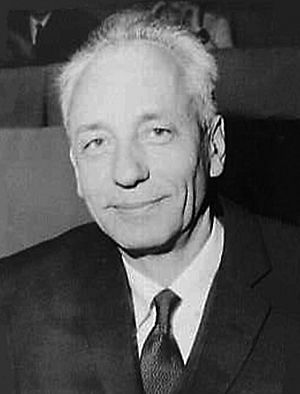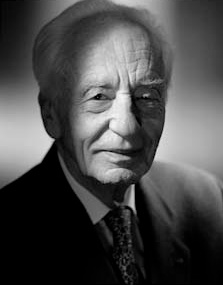Jean Dausset facts for kids
Quick facts for kids
Jean Dausset
|
|
|---|---|
 |
|
| Born | 19 October 1916 Toulouse, France
|
| Died | 6 June 2009 (aged 92) |
| Education | Lycée Michelet |
| Alma mater | University of Paris |
| Known for | major histocompatibility complex, CEPH |
| Spouse(s) | Rose Mayoral |
| Children | Two |
| Awards | Nobel Prize in Physiology or Medicine (1980), Wolf Prize in Medicine (1978) |
| Scientific career | |
| Fields | Immunology |
| Institutions | Free French Forces, North Africa; Boston Children's Hospital; Hôpital Saint-Louis, Paris; Institut National de la Santé et de la Recherche Médicale (INSERM) |
| Influenced | Robert Debré |
Jean Dausset (born October 19, 1916 – died June 6, 2009) was a French immunologist. He was born in Toulouse, France. In 1980, Dausset won the Nobel Prize in Physiology or Medicine. He shared it with Baruj Benacerraf and George Davis Snell. They won for finding and studying the genes that make up the major histocompatibility complex. This complex helps our bodies tell the difference between our own cells and foreign invaders. With his Nobel Prize money and a grant, Dausset started the Human Polymorphism Study Center (CEPH) in 1984. It was later renamed the Foundation Jean Dausset-CEPH to honor him. He married Rose Mayoral in 1963, and they had two children, Henri and Irène. Jean Dausset passed away on June 6, 2009, in Majorca, Spain, at 92 years old.
Contents
Early Life and Education
Jean-Baptiste-Gabriel-Joachim Dausset was born on October 19, 1916, in Toulouse, France. He was the youngest of four children. His father, Henri Dausset, was a doctor from the Pyrenees. His mother, Elisabeth Dausset, was a housewife from Lorraine.
After World War I, his family moved to Biarritz. Jean spent most of his childhood there. His father was the head doctor at Bayonne Hospital, which greatly influenced Jean. Jean was taught at home by his mother and a tutor.
When he was 11, his family moved to Paris. He started formal school at Lycée Michelet at age 15. After finishing high school with a focus on mathematics, his father convinced him to study medicine at the University of Paris. Both of his parents died when he was 19, just after he started working as an assistant doctor at Paris Hospitals.
Jean Dausset did not pass an important exam to become an intern at the Paris Hospitals. He was getting ready to try again when World War II started.
Serving During the War
Dausset joined the French army and was sent to Northern Italy for a year. When he came back to Paris in 1940, he studied hard and passed his medical internship exam.
Soon after, Dausset joined the Free French Forces in North Africa. He worked as an ambulance driver. He was first in Morocco, then moved to Tunisia where there was more fighting. Dausset first learned about hematology (the study of blood) by giving many blood transfusions to wounded soldiers. As the war ended in 1944, Dausset returned to Paris. He worked at the Regional Blood Transfusion Center at Saint-Antoine Hospital.
Medical System Changes
After the war, Dausset worked as an intern at the Paris Hospitals. These hospitals were in bad shape and needed big changes. Dausset joined a group of doctors who wanted to improve the French medical system.
Because of his work in this group, Dausset became an advisor to the National Ministry of Education. He worked with a doctor named Robert Debré. They pushed the government to create a committee to change medical education. For the first time in France, hospitals and universities worked together. Doctors also had to teach medical students.
With this new system, research began happening inside hospitals, not just at universities. Doctors were also able to work full-time. These changes were part of the "Debré reform" in 1958.
Jean Dausset's Career and Discoveries
After World War II, Dausset worked with Professor Marcel Bessis. Bessis had created a new way to give blood called exchange transfusion. Dausset worked as an immunohematologist, studying patients with anemia who needed blood transfusions. He noticed these patients lacked both red and white blood cells. In 1948, Dausset went to work as an intern at the Children's Hospital in Boston. He worked in a blood lab there for about four years.
He returned to France in 1952 and continued working with Marcel Bessis. During this time, Dausset did his first official research. With Bessis, Dausset found the first leucocyte (white blood cell) that presents antigens. This discovery was officially described in 1958.
From 1952 to 1957, Dausset worked with many other researchers. He spent most of his time creating new ways to find certain antibodies. He became the head of research at Professor Georges Marchal’s immunohematology lab at Broussais Hospital.
During this time, Dausset performed blood transfusions between volunteers and patients. This helped him study how the body's immune system reacts. He was testing how the white blood cells from the donor's blood worked in the patient's body. In 1958, Dausset found an antibody called MAC. It caused white blood cells to clump together (a leuco-agglutinate). MAC stood for the first letters of the donors' names.
From 1960 to 1965, Dausset mainly worked on improving organ transplantation techniques. He studied how to help the body accept new tissue. He used blood from volunteers and patients to find differences and learn how to reduce them.
In 1965, there was a lot of competition among researchers in immunohematology. Everyone was close to making big discoveries in genetics and transplantation. Dausset worked with Paul Ivany in Prague. They used techniques to clump white blood cells and test their toxicity. They discovered the Hu-1 antigen and the H-2 antigen.
In 1963, Jean Dausset became the head of immunology at the Hôpital Saint-Louis. Here, he discovered the HLA system with Felix Rapaport. They did skin transplant experiments on volunteers. They showed that successful transplants depended on how well the tissues matched (called histocompatibility).
Dausset was the assistant director of the Research Institute in Blood diseases until 1968. Then, he became the director of the "Institut National de la Santé et de la Recherche Médicale" (INSERM) transplantation immunogenetics research unit. Dausset also started France Transplant and France Greffe de Moelle. These organizations help match donor organs to patients and provide bone marrow for transplants.
Important Research Discoveries
Dausset started his research shortly after becoming a doctor in 1945. He worked in the hematology lab at the Children’s Hospital in Boston. His first scientific paper was published in 1950. It was about finding incomplete antibodies using a special technique that was more sensitive than others at the time.
He continued to publish more work in hematology. In 1952, he developed a method to remove plasma from red blood cells. This was used for transfusions to patients who could not handle whole blood.
In 1952, he returned to France and kept doing research. He focused on hemolytic anemia, a condition where red blood cells are destroyed. He published several papers about different ways blood cells clump together. It was during this time, in 1954, that Dausset first saw a substance that caused leucocytes to clump. However, it wasn't until 1958 that he identified a specific isoantibody for leucocytes and published his findings. This discovery and the many studies that followed eventually led to his Nobel Prize.
Dausset continued his general research on antibodies, clumping, and anemia in the years after his 1958 paper. In 1962, Dausset published a study linking white blood cell clumping to how well skin grafts were accepted. This was his first observation of how antigens affect histocompatibility (tissue matching).
His next paper on this topic came out in 1964. He found a clear link between how well leucocyte antigens matched and the body's immune response to skin grafts. This finding led to a lot of research on histocompatibility. By the end of 1965, Dausset had published over a dozen papers exploring white blood cell antigens and their importance for tissue matching.
After finding that a group of two-gene white blood cell antigens affected tissue matching, Dausset created a system to group white blood cell antigens based on histocompatibility. He then suggested that all known white blood cell antigens were part of a single complex, which he called Hu-1. This complex later became known as one of the Major Histocompatibility Complexes (MHC), specifically the Human Leucocyte Antigens (HLA). Dausset's further work in 1965 showed that injecting Hu-1 antigens affected skin graft rejection. This confirmed that the Hu-1 complex was indeed a transplantation antigen. This conclusion would later have a huge impact on how transplants are done.
In the years that followed, Dausset continued his research on the Hu-1 complex. From 1966-1967, he published more papers. These included a summary of how Hu-1 antigens relate to cancer and transplantation. He also developed a test to find which antigens were present. He discovered that Hu-1 was similar to the mouse H-2 complex, which also helps with tissue matching. By the end of 1967, he confirmed through family studies that all discovered antigens were part of one system.
After 1967, Dausset took part in many other studies about the complex (which was renamed HLA in 1968). These studies looked at how the antigens were passed down through genes. He also published many papers where he was the main author. For his work and his key role in discovering this important antigen, Jean Dausset received the Nobel Prize in Physiology or Medicine in 1980.
After winning the Nobel Prize, Dausset's personal research slowed down. He helped with many studies, especially in genetics. However, he did not publish anything as the main author for over ten years. He retired in 2003, at the age of 87.
Winning the Nobel Prize
In 1975, Dausset thought he might be nominated for the Nobel Prize. But nothing happened until February 1980, when rumors started that he might win. At that time, Dausset was planning to go to Quebec, Canada, for a series of talks. He was in a difficult situation. If he won, he wanted to be with his family and colleagues. But if he stayed in France, people might think he was sure he would win, which could lead to disappointment if he didn't. So, he decided to stay in Paris but keep a low profile. As expected, he was awarded the Nobel Prize in 1980. He shared it with Baruj Benacerraf and George Davis Snell.
Later Life and Legacy
In 1984, Dausset founded the Centre D’étude du Polymorphisme Humain (CEPH). Its goal was to find the main genes in humans that cause diseases outside the HLA system. Finding these genes was a very important step in copying and identifying them. This was a big breakthrough for medical genetics.
The CEPH system provided DNA from 61 large families to international centers. These centers were mapping the human genome. Dausset and Professor LL Cavalli-Sforza worked together. They created a DNA resource from different world populations, called the HGDP-CEPH diversity panel. This was used to study human population genetics.
CEPH is a non-profit organization that received some funding from the French government. In 1993, CEPH was renamed the Foundation Jean Dausset-CEPH. In 2003, at 87 years old, Dausset retired and became the president of CEPH.
Dausset was a member of the French Academy of Sciences. He was also a professor at the Collège de France. Dausset was an important foreign member of the National Academy of Sciences, USA. He was also an honorary member of the American Academy of Arts and Sciences. He was a founding Council member and Vice President of the Human Genome Organization. Dausset received many important awards, such as the Landsteiner Award and prizes from the Koch and Wolf Foundations. He also served on the advisory boards of many research institutions.
See also
 In Spanish: Jean Dausset para niños
In Spanish: Jean Dausset para niños


